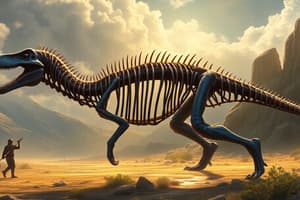Podcast
Questions and Answers
What is primarily studied in paleontology?
What is primarily studied in paleontology?
- Geological layers of the Earth
- Mineral deposits
- Living organisms
- Fossils (correct)
Why are hard-bodied organisms more likely to be preserved as fossils?
Why are hard-bodied organisms more likely to be preserved as fossils?
- They decompose slower than soft-bodied organisms. (correct)
- They are found in sedimentary rocks only.
- They leave behind more trace fossils.
- They attract more mineral deposits.
Which statement best reflects Cuvier's observations about fossil complexity?
Which statement best reflects Cuvier's observations about fossil complexity?
- More complex organisms are found in older rock samples.
- Fossils of complex organisms are more prevalent in shallower rocks.
- Younger rock samples contain less complex fossils. (correct)
- Older rock reveals organisms similar to modern life.
How did Lyell contribute to our understanding of geological change?
How did Lyell contribute to our understanding of geological change?
What does the fossil record suggest about the relationship between birds and reptiles?
What does the fossil record suggest about the relationship between birds and reptiles?
What is biogeography primarily concerned with?
What is biogeography primarily concerned with?
Why might lemurs only be found in Madagascar today?
Why might lemurs only be found in Madagascar today?
What does it imply if organisms that are geographically close have higher relatedness?
What does it imply if organisms that are geographically close have higher relatedness?
What are homologous structures primarily recognized by?
What are homologous structures primarily recognized by?
What type of structures may indicate common ancestry despite having different functions?
What type of structures may indicate common ancestry despite having different functions?
Which statement correctly describes vestigial structures?
Which statement correctly describes vestigial structures?
Which of the following best illustrates the modern understanding of evolution?
Which of the following best illustrates the modern understanding of evolution?
How are pseudogenes characterized?
How are pseudogenes characterized?
In the context of molecular biology, what indicates a closer evolutionary relationship between species?
In the context of molecular biology, what indicates a closer evolutionary relationship between species?
Which concept did Darwin lack a clear understanding of?
Which concept did Darwin lack a clear understanding of?
What is one role of competition in evolution?
What is one role of competition in evolution?
Flashcards are hidden until you start studying
Study Notes
The Fossil Record
- Fossils are preserved remains of ancient organisms.
- The study of fossils is called paleontology.
- Fossils reveal organisms that lived on Earth during different time periods.
- Fossils form through gradual replacement by mineral deposits of the remains of buried organisms.
- The formation of fossils is rare because most bodies decompose quickly when oxygen is present.
- Hard-bodied organisms are more likely to fossilize than soft-bodied organisms.
- Organisms can be preserved in amber, volcanic ash, and ice.
- Cuvier noted that fossils of complex organisms are found in younger rock layers and fossils from deeper rock layers are less similar to modern organisms.
- Lyell noted that geological change occurs gradually over time.
- Fossils show intermediate links between groups of organisms.
- Archaeopteryx, a fossil from 150 million years ago, shows characteristics from both reptiles and birds, suggesting that birds evolved from reptiles (or dinosaurs).
Biogeography
- Biogeography studies the geographical distribution of organisms based on living species and fossils.
- Species that are geographically close are more closely related than those that are geographically separated, regardless of environment.
- Darwin observed that remote islands became populated by species that arrived by water or air, which later evolved into new species.
- Lemurs are only found in Madagascar, but fossils show they once existed across Africa.
Anatomy
- Bone structure and function can provide evidence for evolution.
- Homologous Structures have a similar developmental origin, and similar bone, muscle, ligament, tendon, and blood vessel arrangements.
- Similarities in embryonic development also reveal evolutionary relationships through homologous features.
- Analogous Structures perform similar functions but do not have a common evolutionary origin. For example, bird wings vs. insect wings.
- Vestigial Structures are functional in ancestral organisms but have no current function. For example, the pelvic bones of whales are non-functional because they lack hind limbs.
Competition
- Competition exists between individuals of the same species as some individuals are favored by nature over others.
Molecular Biology
- Evolutionary relationships are reflected in the DNA of species.
- Comparing DNA sequences can determine relatedness.
- The more similar the DNA sequences of two species are, the more closely related they are.
Modern Theory of Evolution
- Modern theory expanded on Darwin's original theory of evolution.
- Darwin did not understand how traits were inherited from one generation to the next.
Modern Genetics
- Genetic traits are passed on from one generation to the next.
- Evolutionary change is described as the changes in allele frequencies within a gene pool.
- Natural selection favors some alleles over others.
- Mutations cause genetic variation.
Pseudogenes
- Pseudogenes are vestigial genes that no longer serve a purpose.
Studying That Suits You
Use AI to generate personalized quizzes and flashcards to suit your learning preferences.



